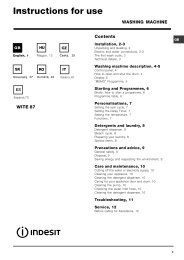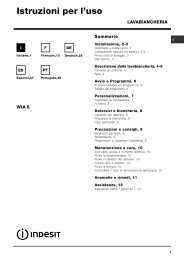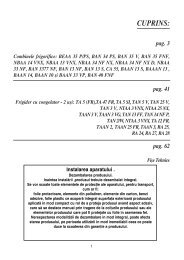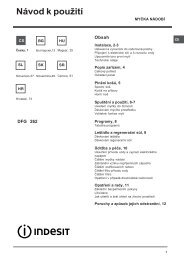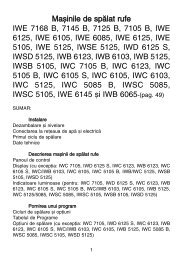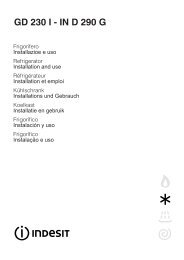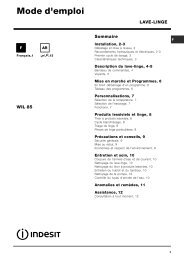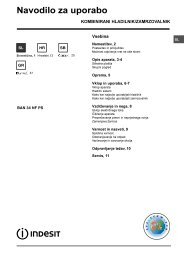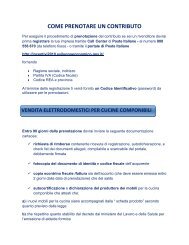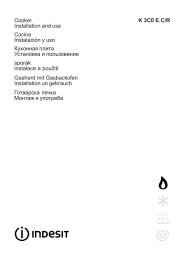You also want an ePaper? Increase the reach of your titles
YUMPU automatically turns print PDFs into web optimized ePapers that Google loves.
<strong>Instructions</strong> <strong>for</strong> <strong>use</strong><br />
WASHING MACHINE<br />
GB<br />
English,1<br />
PT<br />
Português,13<br />
Contents<br />
Installation, 2-3<br />
Unpacking and levelling<br />
Connecting the electricity and water supplies<br />
The first wash cycle<br />
Technical data<br />
GB<br />
Description of the washing machine, 4-5<br />
Control panel<br />
Display<br />
Running a wash cycle, 6<br />
Wash cycles and options, 7<br />
Table of wash cycles<br />
Wash options<br />
IWE 7125 S<br />
Detergents and laundry, 8<br />
Detergent dispenser drawer<br />
Preparing the laundry<br />
Special wash cycles<br />
Load balancing system<br />
Precautions and tips, 9<br />
General safety<br />
Disposal<br />
Opening the porthole door manually<br />
Care and maintenance, 10<br />
Cutting off the water or electricity supply<br />
Cleaning the washing machine<br />
Cleaning the detergent dispenser drawer<br />
Caring <strong>for</strong> the door and drum of your appliance<br />
Cleaning the pump<br />
Checking the water inlet hose<br />
Troubleshooting, 11<br />
Service, 12<br />
1
Installation<br />
GB<br />
! This instruction manual should be kept in a safe<br />
place <strong>for</strong> future reference. If the washing machine is<br />
sold, transferred or moved, make sure that the<br />
instruction manual remains with the machine so that<br />
the new owner is able to familiarise himself/herself<br />
with its operation and features.<br />
! Read these instructions carefully: they contain vital<br />
in<strong>for</strong>mation relating to the safe installation and<br />
operation of the appliance.<br />
Unpacking and levelling<br />
Unpacking<br />
1. Remove the washing machine from its packaging.<br />
2. Make sure that the washing machine has not been<br />
damaged during the transportation process. If it has<br />
been damaged, contact the retailer and do not<br />
proceed any further with the installation process.<br />
3. Remove the 4<br />
protective screws (<strong>use</strong>d<br />
during transportation) and<br />
the rubber washer with<br />
the corresponding<br />
spacer, located on the<br />
rear part of the appliance<br />
(see figure).<br />
4. Close off the holes using the plastic plugs provided.<br />
5. Keep all the parts in a safe place: you will need<br />
them again if the washing machine needs to be<br />
moved to another location.<br />
! Packaging materials should not be <strong>use</strong>d as toys <strong>for</strong><br />
children.<br />
Levelling<br />
1. Install the washing machine on a flat sturdy floor,<br />
without resting it up against walls, furniture cabinets<br />
or anything else.<br />
2. If the floor is not<br />
perfectly level, compensate<br />
<strong>for</strong> any unevenness<br />
by tightening or loosening<br />
the adjustable front feet<br />
(see figure); the angle of<br />
inclination, measured in<br />
relation to the worktop,<br />
must not exceed 2°.<br />
Levelling the machine correctly will provide it with<br />
stability, help to avoid vibrations and excessive noise<br />
and prevent it from shifting while it is operating. If it is<br />
placed on carpet or a rug, adjust the feet in such a<br />
way as to allow a sufficient ventilation space<br />
underneath the washing machine.<br />
Connecting the electricity and water<br />
supplies<br />
Connecting the water inlet hose<br />
1. Connect the supply<br />
pipe by screwing it to a<br />
cold water tab using a 3/4<br />
gas threaded connection<br />
(see figure).<br />
Be<strong>for</strong>e per<strong>for</strong>ming the<br />
connection, allow the<br />
water to run freely until it<br />
is perfectly clear.<br />
2. Connect the inlet hose<br />
to the washing machine<br />
by screwing it onto the<br />
corresponding water inlet<br />
of the appliance, which is<br />
situated on the top righthand<br />
side of the rear part<br />
of the appliance (see<br />
figure).<br />
3. Make sure that the hose is not folded over or bent.<br />
! The water pressure at the tap must fall within the<br />
values indicated in the Technical details table (see<br />
next page).<br />
! If the inlet hose is not long enough, contact a<br />
specialised shop or an authorised technician.<br />
! Never <strong>use</strong> second-hand hoses.<br />
! Use the ones supplied with the machine.<br />
2
Connecting the drain hose<br />
65 - 100 cm<br />
Connect the drain hose,<br />
without bending it, to a<br />
drainage duct or a wall<br />
drain located at a height<br />
between 65 and 100 cm<br />
from the floor;<br />
! Do not <strong>use</strong> extension cords or multiple sockets.<br />
! The cable should not be bent or compressed.<br />
! The power supply cable must only be replaced by<br />
authorised technicians.<br />
Warning! The company shall not be held responsible<br />
in the event that these regulations are not respected.<br />
GB<br />
alternatively, rest it on<br />
the side of a washbasin<br />
or bathtub, fastening the<br />
duct supplied to the tap<br />
(see figure). The free end<br />
of the hose should not<br />
be underwater.<br />
The first wash cycle<br />
Once the appliance has been installed, and be<strong>for</strong>e<br />
you <strong>use</strong> it <strong>for</strong> the first time, run a wash cycle with<br />
detergent and no laundry, using the wash cycle 2.<br />
! We advise against the <strong>use</strong> of hose extensions; if it is<br />
absolutely necessary, the extension must have the<br />
same diameter as the original hose and must not<br />
exceed 150 cm in length.<br />
Technical data<br />
Electrical connections<br />
Be<strong>for</strong>e plugging the appliance into the electricity<br />
socket, make sure that:<br />
• the socket is earthed and complies with all<br />
applicable laws;<br />
• the socket is able to withstand the maximum power<br />
load of the appliance as indicated in the Technical<br />
data table (see opposite);<br />
• the power supply voltage falls within the values<br />
indicated in the Technical data table (see opposite);<br />
• the socket is compatible with the plug of the<br />
washing machine. If this is not the case, replace<br />
the socket or the plug.<br />
! The washing machine must not be installed<br />
outdoors, even in covered areas. It is extremely<br />
dangerous to leave the appliance exposed to rain,<br />
storms and other weather conditions.<br />
! When the washing machine has been installed, the<br />
electricity socket must be within easy reach.<br />
Model<br />
Dimensions<br />
Capacity<br />
Electrical<br />
connections<br />
Water connections<br />
Spin speed<br />
Energy rated<br />
programmes<br />
according to<br />
regulation<br />
EN 60456<br />
IWE 7125 S<br />
width 59.5 cm<br />
height 85 cm<br />
depth 53,5 cm<br />
from 1 to 7 kg<br />
please refer to the technical data<br />
plate fixed to the machine<br />
maximum pressure 1 MPa (10 bar)<br />
minimum pressure 0.05 MPa (0.5 bar)<br />
drum capacity 52 litres<br />
up to 1200 rotations per minute<br />
programme 2; temperature 60°C;<br />
using a load of 7 kg.<br />
This appliance con<strong>for</strong>ms to the<br />
following EC Directives:<br />
- 89/336/EEC dated 03/05/89<br />
(Electromagnetic Compatibility) and<br />
subsequent modifications<br />
- 2002/96/EC<br />
- 2006/95/EC (Low Voltage)<br />
3
Description of the washing<br />
machine<br />
GB<br />
Control panel<br />
ON/OFF<br />
button<br />
TEMPERATURE<br />
Button<br />
OPTION<br />
buttons with<br />
indicator lights<br />
START/PAUSE<br />
button with indicator light<br />
DISPLAY<br />
Detergent dispenser drawer<br />
WASH CYCLE<br />
knob<br />
SPIN SPEED<br />
Button<br />
DELAYED<br />
START Button<br />
Detergent dispenser drawer: <strong>use</strong>d to dispense<br />
detergents and washing additives (see “Detergents<br />
and laundry”).<br />
ON/OFF button : press this briefly to switch the<br />
machine on or off. The START/PAUSE indicator light,<br />
which flashes slowly in a green colour shows that the<br />
machine is switched on. To switch off the washing<br />
machine during the wash cycle, press and hold the<br />
button <strong>for</strong> approximately 3 seconds; if the button is<br />
pressed briefly or accidentally the machine will not<br />
switch off. If the machine is switched off during a<br />
wash cycle, this wash cycle will be cancelled.<br />
WASH CYCLE knob: <strong>use</strong>d to set the desired wash<br />
cycle (see "Table of wash cycles").<br />
OPTION buttons with indicator light: <strong>use</strong>d to select<br />
the available options. The indicator light corresponding<br />
to the selected option will remain lit.<br />
DELAYED START button : press to set a delayed<br />
start time <strong>for</strong> the selected wash cycle. The delay time<br />
will be shown on the display.<br />
START/PAUSE button with indicator light: when<br />
the green indicator light flashes slowly, press the<br />
button to start a wash cycle. Once the cycle has<br />
begun the indicator light will remain lit in a fixed<br />
manner. To pa<strong>use</strong> the wash cycle, press the button<br />
again; the indicator light will flash in an orange colour.<br />
If the symbol is not illuminated, the door may be<br />
opened. To start the wash cycle from the point at<br />
which it was interrupted, press the button again.<br />
Standby mode<br />
This washing machine, in compliance with new<br />
energy saving regulations, is fitted with an automatic<br />
standby system which is enabled after a few minutes<br />
if no activity is detected. Press the ON-OFF button<br />
briefly and wait <strong>for</strong> the machine to start up again.<br />
SPIN button : press to reduce or completely<br />
exclude the spin cycle - the value is indicated on the<br />
display.<br />
TEMPERATURE button : press to decrease or<br />
completely exclude the temperature: the value will be<br />
shown on the display.<br />
4
Display<br />
GB<br />
B<br />
A<br />
C<br />
The display is <strong>use</strong>ful when programming the machine and provides a great deal of in<strong>for</strong>mation.<br />
The duration of the available programmes and the remaining time of a running cycle appear in section A; if the<br />
DELAY START option has been set, the countdown to the start of the selected programme will appear. Pressing<br />
the relative button, the machine automatically displays the maximum temperature and spin speed values set <strong>for</strong><br />
the selected cycle, or the most recently-<strong>use</strong>d settings if they are compatible with the selected cycle.<br />
The "programme phases" relative to the selected programme and the "programme phase" of the running<br />
programme appear in section B:<br />
Wash<br />
Rinse<br />
Spin<br />
Drain<br />
The icons corresponding to "temperature" , "Programmed start" and "spin" appear in section C from top<br />
to bottom:<br />
If the symbol lights up, the display will visualise the set "temperature" value.<br />
When a “delayed start” has been set, the symbol lights up.<br />
If the symbol lights up, the display will visualise the set "spin" value.<br />
Door locked symbol<br />
The lit symbol indicates that the door is locked. To prevent any damage, wait until the symbol turns off be<strong>for</strong>e<br />
opening the door.<br />
To open the door while a cycle is in progress, press the START/PAUSE button; if the DOOR LOCKED symbol is<br />
switched off the door may be opened.<br />
5
Running a wash cycle<br />
GB<br />
1. SWITCH THE MACHINE ON. Press the<br />
button; the START/PAUSE indicator light will flash<br />
slowly in a green colour.<br />
2. LOAD THE LAUNDRY. Open the porthole door.<br />
Load the laundry, making sure you do not exceed<br />
the maximum load value indicated in the table of<br />
programmes on the following page.<br />
3. MEASURE OUT THE DETERGENT. Pull out the<br />
detergent dispenser drawer and pour the detergent<br />
into the relevant compartments as described in<br />
"Detergents and laundry".<br />
4. CLOSE THE DOOR.<br />
5. SELECT THE WASH CYCLE. Set the WASH<br />
CYCLE knob to the desired programme; a<br />
temperature and spin speed is set <strong>for</strong> each wash<br />
cycle; these may be adjusted. The duration of the<br />
cycle will appear on the display.<br />
6. CUSTOMISE THE WASH CYCLE. Use the<br />
relevant buttons:<br />
Modifying the temperature and/or spin<br />
speed. The machine automatically displays the<br />
maximum temperature and spin speed values set<br />
<strong>for</strong> the selected cycle, or the most recently-<strong>use</strong>d<br />
settings if they are compatible with the selected<br />
cycle. The temperature can be decreased by<br />
pressing the button, until the cold wash "OFF"<br />
setting is reached. The spin speed may be<br />
progressively reduced by pressing the button,<br />
until it is completely excluded (the "OFF" setting). If<br />
these buttons are pressed again, the maximum<br />
values are restored.<br />
Setting a delayed start.<br />
To set a delayed start <strong>for</strong> the selected programme,<br />
press the corresponding button repeatedly until the<br />
required delay period has been reached. When this<br />
option is enabled, the symbol lights up on the<br />
display. To remove the delayed start option press<br />
the button until the text "OFF" appears on the<br />
display.<br />
Modifying the cycle<br />
settings.<br />
• Press the button to enable the option; the<br />
indicator light corresponding to the button will<br />
switch on.<br />
• Press the button again to disable the option; the<br />
indicator light will switch off.<br />
! If the selected option is not compatible with the<br />
programmed wash cycle, the indicator light will<br />
flash and the option will not be activated.<br />
! If the selected option is not compatible with<br />
another option which has been selected previously,<br />
the indicator light corresponding to the first option<br />
selected will flash and only the second option will be<br />
activated; the indicator light corresponding to the<br />
enabled option will remain lit.<br />
! The options may affect the recommended load<br />
value and/or the duration of the cycle.<br />
7. START THE PROGRAMME. Press the START/<br />
PAUSE button. The corresponding indicator light will<br />
become green, remaining lit in a fixed manner, and<br />
the door will be locked (the DOOR LOCKED<br />
symbol will be on). To change a wash cycle while<br />
it is in progress, pa<strong>use</strong> the washing machine using<br />
the START/PAUSE button (the START/PAUSE<br />
indicator light will flash slowly in an orange colour);<br />
then select the desired cycle and press the START/<br />
PAUSE button again.<br />
To open the door while a cycle is in progress, press<br />
the START/PAUSE button; if the DOOR LOCKED<br />
symbol is switched off the door may be opened.<br />
Press the START/PAUSE button again to restart the<br />
wash cycle from the point at which it was<br />
interrupted.<br />
8. THE END OF THE WASH CYCLE. This will be<br />
indicated by the text "END" on the display; when<br />
the DOOR LOCKED symbol switches off the door<br />
may be opened. Open the door, unload the laundry<br />
and switch off the machine.<br />
! If you wish to cancel a cycle which has already<br />
begun, press and hold the button. The cycle will be<br />
stopped and the machine will switch off.<br />
6
Wash cycles and options<br />
Table of wash cycles<br />
Wash cycles<br />
Description of the wash cycle<br />
Max.<br />
temp.<br />
(°C)<br />
Max.<br />
speed<br />
(rpm)<br />
Detergents<br />
Prewash Wash Bleach<br />
Fabric<br />
softener<br />
Max. load<br />
(kg)<br />
Normal<br />
Daily<br />
1 Cotton with prewash: extremely soiled whites. 90° 1200 • • - • 7 -<br />
2 Cotton: extremely soiled whites. 90° 1200 - • • • 7 -<br />
2 Cotton (1): heavily soiled whites and resistant colours. 60° 1200 - • • • 7 -<br />
2 Cotton (2): heavily soiled whites and delicate colours. 40° 1200 - • • • 7 -<br />
3 Cotton: heavily soiled whites and resistant colours. 60° 1200 - • • • 7 3,5<br />
4 Coloured Cottons (3): lightly soiled whites and delicate colours. 40° 1200 - • • • 7 3,5<br />
5 Synthetics: lightly soiled resistant colours. 60° 800 - • • • 3 2<br />
Special<br />
6 Wool: <strong>for</strong> wool, cashmere, etc. 40° 600 - • - • 1,5 -<br />
7 Silk/Curtains: <strong>for</strong> garments in silk and viscose, lingerie. 30° 0 - • - • 1 -<br />
8 Jeans 40° 800 - • - • 3 -<br />
9<br />
Express: to refresh lightly soiled garments quickly (not suitable <strong>for</strong><br />
wool, silk and clothes which require washing by hand).<br />
30° 800 - • - • 1,5 -<br />
10 Outwear 30° 400 - • - - 2 -<br />
Sport<br />
Eco<br />
Time<br />
Cycle<br />
duration<br />
11 Sport Intensive 30° 600 - • - • 3 -<br />
12 Sport Light 30° 600 - • - • 3 -<br />
Max. 2<br />
13 Sport Shoes 30° 600 - • - •<br />
pairs<br />
-<br />
Partial wash cycles<br />
Rinse - 1200 - - • • 7 -<br />
Spin - 1200 - - - - 7 -<br />
Drain - 0 - - - - 7 -<br />
The in<strong>for</strong>mation contained in the table is intended as a guide only.<br />
For all Test Institutes:<br />
1) Test wash cycle in compliance with regulation EN 60456: set wash cycle 2 with a temperature of 60°C.<br />
2) Long wash cycle <strong>for</strong> cottons: set wash cycle 2 with a temperature of 40°C.<br />
3) Short wash cycle <strong>for</strong> cottons: set wash cycle 4 with a temperature of 40°C.<br />
Wash options<br />
Selecting this option enables you to suitably adjust<br />
drum rotation, temperature and water to a reduced<br />
load of lightly soiled cotton and synthetic fabrics (refer<br />
to the "Table of wash cycles"). “ ” enables you<br />
to wash in less time thereby saving water and<br />
electricity. We suggest using a liquid detergent<br />
suitably measured out to the load quantity.<br />
! It cannot be <strong>use</strong>d with the 1, 2, 6, 7, 8, 9, 10, 11,<br />
12, 13, , , programmes.<br />
Stain removal<br />
This option is particularly <strong>use</strong>ful <strong>for</strong> the removal of<br />
stubborn stains. Place extra compartment 4 (supplied)<br />
into compartment 1.<br />
When pouring in the bleach,<br />
be careful not to exceed the<br />
4<br />
"max" level marked on the<br />
central pivot (see figure).To<br />
run the bleach cycle on its<br />
own, pour the bleach into<br />
extra compartment 4, set<br />
1 2 3<br />
the "Rinse" programme<br />
and activate the "Stain<br />
removal" option.<br />
To bleach during a wash<br />
cycle, pour in the detergent<br />
and any fabric softener you wish to <strong>use</strong>, set the desired<br />
wash cycle and enable the "Stain removal" option.<br />
The duration of the wash cycles can be checked<br />
on the display.<br />
The <strong>use</strong> of extra compartment 4 excludes the “Prewash”<br />
option.<br />
! It cannot be <strong>use</strong>d with the 1, 6, 7, 8, 9, 10, 11, 12,<br />
13, , programmes.<br />
Extra rinse<br />
By selecting this option, the efficiency of the rinse is<br />
increased and optimal detergent removal is<br />
guaranteed. It is particularly <strong>use</strong>ful <strong>for</strong> sensitive skin.<br />
! It cannot be <strong>use</strong>d in conjunction with the 9, ,<br />
programmes.<br />
Easy iron<br />
By selecting this function, the wash and spin cycles<br />
will be modified in order to reduce the <strong>for</strong>mation of<br />
creases. At the end of the cycle the washing machine<br />
will per<strong>for</strong>m slow rotations of the drum; the indicator<br />
lights <strong>for</strong> the EASY IRON and START/PAUSE options<br />
will flash (the first one green, the second orange). To<br />
end the cycle, press the START/PAUSE button or the<br />
EASY IRON button. For the 7-10 wash cycles, the<br />
machine will end the cycle while the laundry is<br />
soaking and the EASY IRON and START/PAUSE<br />
indicator lights will flash and the RINSE phase will<br />
remain lit in a fixed manner. To drain the water so that<br />
the laundry may be removed, press the START/<br />
PAUSE button or the EASY IRON button.<br />
! This function may not be <strong>use</strong>d in conjunction with<br />
wash cycles 6, 9, 11, 12, 13, , .<br />
GB<br />
7
Detergents and laundry<br />
GB<br />
Detergent dispenser drawer<br />
Good washing results also depend on the correct<br />
dose of detergent: adding too much detergent will not<br />
necessarily result in a more efficient wash, and may in<br />
fact ca<strong>use</strong> build up on the inside of your appliance<br />
and contribute to environmental pollution.<br />
! Do not <strong>use</strong> hand washing detergents beca<strong>use</strong> these<br />
create too much foam.<br />
Open the detergent<br />
4<br />
dispenser drawer and<br />
pour in the detergent or<br />
washing additive, as<br />
follows.<br />
1 2 3<br />
compartment 1: Pre-wash detergent (powder)<br />
Be<strong>for</strong>e pouring in the detergent, make sure that extra<br />
compartment 4 has been removed.<br />
compartment 2: Detergent <strong>for</strong> the wash cycle<br />
(powder or liquid)<br />
Liquid detergent should only be poured in immediately<br />
prior to the start of the wash cycle.<br />
compartment 3: Additives (fabric softeners, etc.)<br />
The fabric softener should not overflow the grid.<br />
extra compartment 4: Bleach<br />
Preparing the laundry<br />
• Divide the laundry according to:<br />
- the type of fabric/the symbol on the label<br />
- the colours: separate coloured garments from whites.<br />
• Empty all garment pockets and check the buttons.<br />
• Do not exceed the listed values, which refer to the<br />
weight of the laundry when dry:<br />
Durable fabrics: max. 7 kg<br />
Synthetic fabrics: max. 3 kg<br />
Delicate fabrics: max. 2 kg<br />
Wool: max. 1,5 kg<br />
Silk: max. 1 kg<br />
How much does your laundry weigh?<br />
1 sheet 400-500 g<br />
1 pillow case 150-200 g<br />
1 tablecloth 400-500 g<br />
1 bathrobe 900-1200 g<br />
1 towel 150-250 g<br />
Special wash cycles<br />
Wool: All wool garments can be washed using<br />
programme 6, even those carrying the "hand-wash<br />
only" label. For best results, <strong>use</strong> special<br />
detergents and do not exceed 1,5 kg of laundry.<br />
Silk: <strong>use</strong> special wash cycle 7 to wash all silk<br />
garments. We recommend the <strong>use</strong> of special<br />
detergent which has been designed to wash delicate<br />
clothes.<br />
Curtains: fold curtains and place them in a pillow<br />
case or mesh bag. Use wash cycle 7.<br />
Jeans: Turn garments inside-out be<strong>for</strong>e washing and<br />
<strong>use</strong> a liquid detergent. Use programme 8.<br />
Express: this wash cycle was designed to wash<br />
lightly soiled garments quickly: it lasts just 15 minutes<br />
and there<strong>for</strong>e saves both energy and time. By<br />
selecting this wash cycle (9 at 30°C), it is possible to<br />
wash different fabrics together (except <strong>for</strong> wool and<br />
silk items), with a maximum load of 1.5 kg.<br />
Outwear (wash cycle 10): is studied <strong>for</strong> washing<br />
water-repellent fabrics and winter jackets (e.g. Gore-<br />
Tex, polyester, nylon); <strong>for</strong> best results, <strong>use</strong> a liquid<br />
detergent and dosage suitable <strong>for</strong> a half-load; pretreat<br />
necks, cuffs and stains if necessary; do not <strong>use</strong><br />
softeners or detergents containing softeners. Stuffed<br />
duvets cannot be washed with this programme.<br />
Sport Intensive (wash cycle 11): is <strong>for</strong> washing<br />
heavily soiled sports clothing fabrics (tracksuits,<br />
shorts, etc.); <strong>for</strong> best results, we recommend not<br />
exceeding the maximum load indicated in the "Table<br />
of wash cycles".<br />
Sport Light (wash cycle 12): is <strong>for</strong> washing lightly<br />
soiled sports clothing fabrics (tracksuits, shorts, etc.);<br />
<strong>for</strong> best results, we recommend not exceeding the<br />
maximum load indicated in the "Table of wash<br />
cycles". We recommend using a liquid detergent and<br />
dosage suitable <strong>for</strong> a half-load.<br />
Sport Shoes (wash cycle 13): is <strong>for</strong> washing sports<br />
shoes; <strong>for</strong> best results, do not wash more than 2 pairs<br />
simultaneously.<br />
Load balancing system<br />
Be<strong>for</strong>e every spin cycle, to avoid excessive vibrations<br />
and to distribute the load in a uni<strong>for</strong>m manner, the<br />
drum rotates continuously at a speed which is slightly<br />
greater than the washing rotation speed. If, after<br />
several attempts, the load is not balanced correctly,<br />
the machine spins at a reduced spin speed. If the<br />
load is excessively unbalanced, the washing machine<br />
per<strong>for</strong>ms the distribution process instead of spinning.<br />
To encourage improved load distribution and balance,<br />
we recommend small and large garments are mixed<br />
in the load.<br />
8
Precautions and tips<br />
! This washing machine was designed and<br />
constructed in accordance with international safety<br />
regulations. The following in<strong>for</strong>mation is provided <strong>for</strong><br />
safety reasons and must there<strong>for</strong>e be read carefully.<br />
General safety<br />
• This appliance was designed <strong>for</strong> domestic <strong>use</strong> only.<br />
• The washing machine must only be <strong>use</strong>d by adults, in<br />
accordance with the instructions provided in this manual.<br />
• Do not touch the machine when barefoot or with<br />
wet or damp hands or feet.<br />
• Do not pull on the power supply cable when<br />
unplugging the appliance from the electricity<br />
socket. Hold the plug and pull.<br />
• Do not open the detergent dispenser drawer while<br />
the machine is in operation.<br />
• Do not touch the drained water as it may reach<br />
extremely high temperatures.<br />
• Never <strong>for</strong>ce the porthole door. This could damage<br />
the safety lock mechanism designed to prevent<br />
accidental opening.<br />
• If the appliance breaks down, do not under any<br />
circumstances access the internal mechanisms in<br />
an attempt to repair it yourself.<br />
• Always keep children well away from the appliance<br />
while it is operating.<br />
• The door can become quite hot during the wash cycle.<br />
• If the appliance has to be moved, work in a group<br />
of two or three people and handle it with the utmost<br />
care. Never try to do this alone, beca<strong>use</strong> the<br />
appliance is very heavy.<br />
• Be<strong>for</strong>e loading laundry into the washing machine,<br />
make sure the drum is empty.<br />
Disposal<br />
• Disposing of the packaging materials: observe local<br />
regulations so that the packaging may be re-<strong>use</strong>d.<br />
• The European Directive 2002/96/EC on Waste<br />
Electrical and Electronic Equipment, requires that<br />
old ho<strong>use</strong>hold electrical appliances must not be<br />
disposed of in the normal unsorted municipal waste<br />
stream. Old appliances must be collected<br />
separately in order to optimise the recovery and<br />
recycling of the materials they contain and reduce<br />
the impact on human health and the environment.<br />
The crossed out "wheeled bin" symbol on the<br />
product reminds you of your obligation, that when<br />
you dispose of the appliance it must be separately<br />
collected.<br />
Consumers should contact their local authority or<br />
retailer <strong>for</strong> in<strong>for</strong>mation concerning the correct<br />
disposal of their old appliance.<br />
Opening the porthole door manually<br />
In the event that it is not possible to open the<br />
porthole door due to a powercut, and if you wish to<br />
remove the laundry, proceed as follows:<br />
20<br />
1. remove the plug from<br />
the electrical socket.<br />
2. make sure the water<br />
level inside the machine is<br />
lower than the door<br />
opening; if it is not, remove<br />
excess water using the<br />
drain hose, collecting it in a<br />
bucket as indicated in the<br />
figure.<br />
3. using a screwdriver,<br />
remove the cover panel on<br />
the lower front part of the<br />
washing machine (see<br />
figure).<br />
4. pull outwards using the tab as indicated in the<br />
figure, until the plastic tie-rod is freed from its stop<br />
position; pull downwards and open the door at the<br />
same time.<br />
5. reposition the panel, making sure the hooks are<br />
securely in place be<strong>for</strong>e you push it onto the<br />
appliance.<br />
GB<br />
9
Care and maintenance<br />
GB<br />
Cutting off the water and electricity<br />
supplies<br />
• Turn off the water tap after every wash cycle. This<br />
will limit wear on the hydraulic system inside the<br />
washing machine and help to prevent leaks.<br />
• Unplug the washing machine when cleaning it and<br />
during all maintenance work.<br />
Cleaning the washing machine<br />
The outer parts and rubber components of the<br />
appliance can be cleaned using a soft cloth soaked<br />
in lukewarm soapy water. Do not <strong>use</strong> solvents or<br />
abrasives.<br />
Cleaning the detergent dispenser<br />
drawer<br />
Remove the dispenser<br />
by raising it and pulling it<br />
out (see figure).<br />
Wash it under running<br />
water; this operation<br />
should be repeated<br />
frequently.<br />
Cleaning the pump<br />
The washing machine is fitted with a self-cleaning<br />
pump which does not require any maintenance.<br />
Sometimes, small items (such as coins or buttons)<br />
may fall into the pre-chamber which protects the<br />
pump, situated in its bottom part.<br />
! Make sure the wash cycle has finished and unplug<br />
the appliance.<br />
To access the pre-chamber:<br />
1. using a screwdriver,<br />
remove the cover panel<br />
on the lower front part of<br />
the washing machine<br />
(see figure);<br />
2. unscrew the lid by<br />
rotating it anti-clockwise<br />
(see figure): a little water<br />
may trickle out. This is<br />
perfectly normal;<br />
Caring <strong>for</strong> the door and drum of your<br />
appliance<br />
• Always leave the porthole door ajar in order to<br />
prevent unpleasant odours from <strong>for</strong>ming.<br />
3. clean the inside thoroughly;<br />
4. screw the lid back on;<br />
5. reposition the panel, making sure the hooks are<br />
securely in place be<strong>for</strong>e you push it onto the<br />
appliance.<br />
Checking the water inlet hose<br />
Check the inlet hose at least once a year. If there are<br />
any cracks, it should be replaced immediately: during<br />
the wash cycles, water pressure is very strong and a<br />
cracked hose could easily split open.<br />
! Never <strong>use</strong> second-hand hoses.<br />
10
Troubleshooting<br />
Your washing machine could fail to work. Be<strong>for</strong>e contacting the Technical Assistance Centre (see “Assistance”),<br />
make sure that the problem cannot be not solved easily using the following list.<br />
GB<br />
Problem:<br />
The washing machine does not<br />
switch on.<br />
The wash cycle does not start.<br />
The washing machine does not<br />
take in water ("H2O" will flash<br />
on the display).<br />
The washing machine<br />
continuously takes in and<br />
drains water.<br />
The washing machine does not<br />
drain or spin.<br />
The washing machine vibrates a<br />
lot during the spin cycle.<br />
The washing machine leaks.<br />
The "option" indicator lights and the<br />
"start/pa<strong>use</strong>" indicator light flash<br />
and an error code appears on the<br />
display (e.g.: F-01, F-..).<br />
There is too much foam.<br />
Possible ca<strong>use</strong>s / Solutions:<br />
• The appliance is not plugged into the socket fully, or is not making contact.<br />
• There is no power in the ho<strong>use</strong>.<br />
• The washing machine door is not closed properly.<br />
• The ON/OFF button has not been pressed.<br />
• The START/PAUSE button has not been pressed.<br />
• The water tap has not been opened.<br />
• A delayed start has been set (see “Running a wash cycle”).<br />
• The water inlet hose is not connected to the tap.<br />
• The hose is bent.<br />
• The water tap has not been opened.<br />
• There is no water supply in the ho<strong>use</strong>.<br />
• The pressure is too low.<br />
• The START/PAUSE button has not been pressed.<br />
• The drain hose is not fitted at a height between 65 and 100 cm from<br />
the floor (see “Installation”).<br />
• The free end of the hose is under water (see “Installation”).<br />
• The wall drainage system is not fitted with a breather pipe.<br />
If the problem persists even after these checks, turn off the water tap,<br />
switch the appliance off and contact the Assistance Service. If the<br />
dwelling is on one of the upper floors of a building, there may be problems<br />
relating to water drainage, causing the washing machine to fill with water<br />
and drain continuously. Special anti-draining valves are available in shops<br />
and help to avoid this inconvenience.<br />
• The wash cycle does not include draining: some wash cycles require the<br />
drain phase to be started manually.<br />
• The “Easy iron” option has been activated: To complete the wash cycle,<br />
press the START/PAUSE button (see “Wash cycles and options”).<br />
• The drain hose is bent (see “Installation”).<br />
• The drainage duct is clogged.<br />
• The drum was not unlocked correctly during installation (see “Installation”).<br />
• The washing machine is not level (see “Installation”).<br />
• The washing machine is trapped between cabinets and walls (see “Installation”).<br />
• The water inlet hose is not screwed on properly (see “Installation”).<br />
• The detergent dispenser drawer is blocked (<strong>for</strong> cleaning instructions, see “Care<br />
and maintenance”).<br />
• The drain hose is not fixed properly (see “Installation”).<br />
• Switch off the machine and unplug it, wait <strong>for</strong> approximately 1 minute<br />
and then switch it back on again.<br />
If the problem persists, contact the Technical Assistance Service.<br />
• The detergent is not suitable <strong>for</strong> machine washing (it should display the<br />
text “<strong>for</strong> washing machines” or “hand and machine wash”, or the like).<br />
• Too much detergent was <strong>use</strong>d.<br />
11
Service<br />
GB<br />
Be<strong>for</strong>e calling <strong>for</strong> Assistance:<br />
• Check whether you can solve the problem alone (see “Troubleshooting”);<br />
• Restart the programme to check whether the problem has been solved;<br />
• If this is not the case, contact an authorised Technical Assistance Centre using the telephone number<br />
provided on the guarantee certificate.<br />
! Always request the assistance of authorised technicians.<br />
Have the following in<strong>for</strong>mation to hand:<br />
• the type of problem;<br />
• the appliance model (Mod.);<br />
• the serial number (S/N).<br />
This in<strong>for</strong>mation can be found on the data plate applied to the rear of the washing machine, and can also<br />
be found on the front of the appliance by opening the door.<br />
12
Instruções para utilização<br />
MÁQUINA DE LAVAR ROUPA<br />
PT<br />
Português<br />
IWE 7125 S<br />
Sumário<br />
Instalação, 14-15<br />
Desembalar e nivelar<br />
Ligações hidráulicas e eléctricas<br />
Primeiro ciclo de lavagem<br />
Dados técnicos<br />
Descrição da máquina de lavar roupa, 16-17<br />
Painel de comandos<br />
Visor<br />
Como efectuar um ciclo de lavagem, 18<br />
Programas e funções, 19<br />
Tabela dos programas<br />
Funções de lavagem<br />
Detergentes e roupa, 20<br />
Gaveta dos detergentes<br />
Preparar a roupa<br />
Programas especiais<br />
Sistema de balanceamento da carga<br />
Precauções e conselhos, 21<br />
Segurança geral<br />
Eliminação<br />
Abertura manual da porta de vidro<br />
Manutenção e cuidados, 22<br />
Interromper a alimentação de água e de corrente eléctrica<br />
Limpar a máquina de lavar roupa<br />
Limpar a gaveta dos detergentes<br />
Cuidados com a porta de vidro e o tambor<br />
Limpar a bomba<br />
Verificar o tubo de alimentação de água<br />
Anomalias e soluções, 23<br />
Assistência, 24<br />
PT<br />
13
Instalação<br />
PT<br />
! É importante guardar este manual para poder<br />
consultá-lo a qualquer momento. Se a máquina <strong>for</strong><br />
vendida, cedida ou transferida, certifique-se que este<br />
manual permaneça com a máquina para in<strong>for</strong>mar o<br />
novo proprietário acerca do seu funcionamento e das<br />
respectivas advertências.<br />
! Leia com atenção estas instruções: há importantes<br />
in<strong>for</strong>mações acerca da instalação, da utilização e da<br />
segurança.<br />
Desembalar e nivelar<br />
Desembalar<br />
1. Tire a máquina de lavar roupa da embalagem.<br />
2. Verifique se a máquina de lavar roupa sofreu danos<br />
no transporte. Se estiver danificada não efectue a<br />
sua ligação e contacte o revendedor.<br />
3. Tire os 4 parafusos de<br />
protecção para o<br />
transporte e a<br />
borrachinha com o<br />
respectivo calço,<br />
situados na parte traseira<br />
(veja a figura).<br />
4. Tampe os furos com as tampas em plástico<br />
<strong>for</strong>necidas.<br />
5. Guarde todas as peças: se <strong>for</strong> necessário<br />
transportar a máquina de lavar roupa, terão de ser<br />
montadas outra vez.<br />
! Embalagens não são brinquedos para as crianças!<br />
Nivelamento<br />
1. Instale a máquina de lavar roupa sobre um pavimento<br />
plano e rígido, sem encostá-la em paredes,<br />
móveis nem outro.<br />
2. Se o pavimento não<br />
<strong>for</strong> perfeitamente<br />
horizontal, para compensar<br />
qualquer<br />
irregularidade,<br />
desatarraxe ou atarraxe<br />
os pés dianteiros (veja a<br />
figura); o ângulo de<br />
inclinação, medido no<br />
plano de trabalho, não<br />
deve ultrapassar 2°.<br />
Um cuidadoso nivelamento dá estabilidade à máquina<br />
e evita vibrações, ruídos e deslocamentos durante o<br />
funcionamento. Se houver tapete ou alcatifa, regule<br />
os pés em modo que embaixo da máquina de lavar<br />
roupa deixe um espaço suficiente para ventilação.<br />
Ligações hidráulicas e eléctricas<br />
Ligação do tubo de alimentação da água<br />
1. Realize a ligação do<br />
tubo de alimentação<br />
parafusando-o a uma<br />
torneira de água fria com<br />
bocal de rosca 3/4 gás<br />
(veja a figura).<br />
Antes de realizar esta<br />
ligação, deixe a água<br />
escorrer até estar<br />
límpida.<br />
2. Ligue o tubo de<br />
alimentação na máquina<br />
de lavar roupa<br />
atarraxando-o no<br />
apropriado <strong>for</strong>necimento<br />
da água, na parte<br />
traseira, em cima à<br />
direita (veja a figura).<br />
3. Tome cuidado para o tubo não ser dobrado nem<br />
esmagado.<br />
! A pressão hídrica da torneira deve ser entre os<br />
valores da tabela dos Dados técnicos (veja a página<br />
ao lado).<br />
! Se o comprimento do tubo de alimentação não <strong>for</strong><br />
suficiente, contacte uma oficina especializada ou um<br />
técnico autorizado.<br />
! Nunca utilize tubos já usados.<br />
! Utilize aqueles <strong>for</strong>necidos com a máquina.<br />
14
Ligação do tubo de descarga<br />
65 - 100 cm<br />
Ligue o tubo de<br />
descarga, sem dobrá-lo,<br />
a um conduto de<br />
descarga ou a uma<br />
descarga de parede<br />
colocados entre 65 e 100<br />
cm do chão;<br />
! Não empregue extensões nem fichas múltiplas.<br />
! O cabo não deve ser dobrado nem apertado.<br />
! O cabo de alimentação deve ser substituído<br />
somente por técnicos autorizados.<br />
Atenção! O fabricante declina toda a responsabilidade<br />
se estas regras não <strong>for</strong>em respeitadas.<br />
PT<br />
em alternativa, coloque<br />
na beira de um lavabo<br />
ou de uma banheira,<br />
prendendo na torneira a<br />
guia <strong>for</strong>necida (veja a<br />
figura). A ponta solta do<br />
tubo de descarga não<br />
deve permanecer<br />
emergida na água.<br />
Primeiro ciclo de lavagem<br />
Depois da instalação, antes de usar, efectue um ciclo<br />
de lavagem com detergente mas sem roupa, defina o<br />
programa 2.<br />
! É desaconselhado empregar tubos de extensão;<br />
mas se <strong>for</strong> indispensável, a extensão deve ter o<br />
mesmo diâmetro do tubo original e não medir mais de<br />
150 cm de comprimento.<br />
Dados técnicos<br />
Ligação eléctrica<br />
Antes de ligar a ficha na tomada eléctrica, certifiquese<br />
que:<br />
• a tomada tenha uma ligação à terra e seja nos<br />
termos da legislação;<br />
• a tomada tenha a capacidade para suportar a<br />
carga máxima de potência da máquina, indicada na<br />
tabela dos Dados técnicos (veja ao lado);<br />
• a tensão de alimentação seja entre os valores<br />
indicados na tabela dos Dados técnicos (veja ao<br />
lado);<br />
• a tomada seja compatível com a ficha da máquina<br />
de lavar roupa. Se não <strong>for</strong>, substitua a tomada ou a<br />
ficha.<br />
! Esta máquina de lavar roupa não deve ser instalada<br />
ao aberto, nem mesmo abrigada, porque é muito<br />
perigoso deixá-la exposta à chuva e às tempestades.<br />
! Depois de ter instalado a máquina de lavar roupa, o<br />
acesso à tomada eléctrica deve ser fácil.<br />
Modelo<br />
Medidas<br />
Capacidade<br />
Ligações<br />
eléctricas<br />
Ligações hídricas<br />
Velocidade da<br />
centrifugação<br />
Programas de<br />
controlo segundo<br />
a norma EN 60456<br />
IWE 7125 S<br />
largura 59,5 cm.<br />
altura 85 cm.<br />
profundidade 53,5 cm.<br />
de 1 a 7 kg.<br />
veja a placa das características<br />
técnicas colocada na máquina<br />
pressão máxima 1 MPa (10 bars)<br />
pressão mínima 0,05 MPa (0,5 bar)<br />
capacidade do tambor 52 litros<br />
até 1200 rotações por minuto<br />
programa 2; temperatura 60°C;<br />
realizado com carga de 7 kg.<br />
Esta aparelhagem é em<br />
con<strong>for</strong>midade com as seguintes<br />
Directivas Comunitárias:<br />
- 89/336/CEE dl 03/05/89<br />
(Compatibilidade Electromagnética) e<br />
posteriores modificações.<br />
- 2002/96/CE<br />
- 2006/95/CE (Baixa Tensão)<br />
15
Descrição da máquina de lavar<br />
roupa<br />
PT<br />
Painel de comandos<br />
Tecla de LIGA/<br />
DESLIGA<br />
Tecla<br />
TEMPERATURA<br />
Teclas com indicadores<br />
luminosos de<br />
FUNÇÕES<br />
Tecla com indicador<br />
luminoso INÍCIO/<br />
PAUSA<br />
VISOR<br />
Gaveta dos detergentes<br />
Selector de<br />
PROGRAMAS<br />
Tecla<br />
CENTRIFUGAÇÃO<br />
Tecla<br />
INÍCIO POSTERIOR<br />
Gaveta dos detergentes: para colocar detergentes<br />
e aditivos (veja “Detergentes e roupa”).<br />
Tecla LIGA/DESLIGA : carregue brevemente na<br />
tecla para ligar ou desligar a máquina. O indicador<br />
luminoso INÍCIO/PAUSA que pisca lentamente com a<br />
cor verde, indica que a máquina está ligada. Para<br />
desligar a máquina de lavar roupa durante a lavagem,<br />
é necessário manter pressionado a tecla por mais<br />
tempo, aproximadamente 2 segundos; uma pressão<br />
breve ou acidental não anulará o funcionamento da<br />
máquina. O desligar a máquina durante uma lavagem<br />
em curso anula a própria lavagem.<br />
Selector de PROGRAMAS: para seleccionar o<br />
programa desejado (veja a "Tabela dos programas").<br />
Teclas com indicadores luminosos de FUNÇÕES:<br />
para seleccionar as funções disponíveis. O indicador<br />
luminoso correspondente à função seleccionada<br />
permanecerá aceso.<br />
Tecla CENTRIFUGAÇÃO : pressionar para reduzir<br />
ou excluir completamente a centrifugação - o valor é<br />
indicado no visor.<br />
Tecla INÍCIO POSTERIOR : pressionar para<br />
programar um início atrasado do programa escolhido.<br />
O atraso é indicado no visor.<br />
Tasto com indicador luminoso INÍCIO/PAUSA :<br />
quando o indicador luminoso verde, acender<br />
intermitentemente, carregue na tecla para iniciar uma<br />
lavagem. Quando o ciclo iniciar, o indicador<br />
permanecerá aceso fixo. Para colocar em pausa a<br />
lavagem, carregar novamente no botão; o indicador<br />
ficará intermitente com uma luz laranja. Se o símbolo<br />
não estiver iluminado, será possível abrir a porta de<br />
vidro. Para fazer iniciar a lavagem do ponto em que<br />
foi interrompida, carregar novamente na tecla.<br />
Modalidade de Stand by<br />
Esta máquina de lavar roupa, em con<strong>for</strong>midade com<br />
as novas normas sobre a economia energética,<br />
dispõe de um sistema de desligação automática<br />
(stand by) que entra em função alguns minutos<br />
depois, no caso de inutilização. Carregue brevemente<br />
no botão LIGA/DESLIGA e aguarde até a reactivação<br />
da máquina.<br />
Tecla TEMPERATURA : pressionar para reduzir ou<br />
excluir a temperatura; o valor é indicado no visor.<br />
16
Visor<br />
B<br />
PT<br />
A<br />
C<br />
O visor é útil para programar a máquina e <strong>for</strong>nece muitas in<strong>for</strong>mações.<br />
Na secção A é visualizada a duração dos vários programas à disposição e com o ciclo iniciado o tempo faltante<br />
para o fim do mesmo; no caso em que tenha sido programado um INÍCIO POSTERIOR, será visualizado o tempo<br />
faltante ao início do programa seleccionado. Além disto, ao carregar na respectiva tecla, a máquina visualiza<br />
automaticamente a temperatura e a centrifugação máximas para o programa seleccionado ou as últimas<br />
seleccionadas se compatíveis com o programa escolhido.<br />
Na secção B são visualizadas as "fases de lavagem" previstas para o ciclo seleccionado e com o programa<br />
iniciado a "fase de lavagem" em curso.<br />
Lavagem<br />
Enxaguamento<br />
Centrifugação<br />
Descarga<br />
Na secção C estão presentes, partindo de cima para baixo, os ícones relativos à "temperatura"<br />
posterior" e à "Centrifugação" :<br />
O símbolo iluminado indica que no visor é visualizado o valor da "temperatura" configurado.<br />
O símbolo iluminado indica que foi configurado um "Início posterior".<br />
O símbolo iluminado indica que no visor é visualizado o valor da "centrifugação" configurado.<br />
, ao "Início<br />
Simbolo Porta de vidro bloqueada<br />
O símbolo aceso indica que a porta está bloqueada. Para evitar danos é necessário aguardar que o símbolo<br />
apague-se antes de abrir a porta de vidro.<br />
Para abrir a porta durante a realização de um ciclo, carregar no botão INÍCIO/PAUSA; se o símbolo PORTA DE<br />
VIDRO BLOQUEADA estiver apagado será possível abrir a porta.<br />
17
Como efectuar um ciclo de<br />
lavagem<br />
PT<br />
1. LIGAR A MÁQUINA. Carregue no botão ; o<br />
indicador luminoso INÍCIO/PAUSA irá piscar<br />
lentamente com a cor verde.<br />
2. COLOCAR A ROUPA. Abrir a porta de vidro.<br />
Coloque a roupa dentro da máquina prestando<br />
atenção para não superar a carga máxima indicada<br />
na tabela dos programas na página seguinte.<br />
3. DOSAGEM DO DETERGENTE. Extrair a gaveta<br />
e deitar o detergente nos específicos recipientes<br />
como explicado no parágrafo "Detergentes e<br />
roupa".<br />
4. FECHAR A PORTA DE VIDRO.<br />
5. ESCOLHA DE PROGRAMA. Seleccione mediante<br />
o selector de PROGRAMAS o programa que<br />
desejar; será associada uma temperatura e uma<br />
velocidade de centrifugação que podem ser<br />
modificadas. No visor aparecerá a duração do<br />
ciclo.<br />
6. PERSONALIZAR O CICLO DE LAVAGEM.<br />
Utilizar as específicas teclas:<br />
Modificar a temperatura e/ou a<br />
centrifugação. A máquina visualiza<br />
automaticamente a temperatura e a centrifugação<br />
máximas para o programa seleccionado ou as<br />
últimas seleccionadas se compatíveis com o<br />
programa escolhido. Carregando no botão<br />
pode-se reduzir a temperatura progressivamente<br />
até a lavagem a frio "OFF". Carregando no botão<br />
pode-se reduzir a centrifugação<br />
progressivamente até a sua exclusão "OFF". Uma<br />
nova pressão dos botões colocará os valores<br />
novamente nos máximos previstos.<br />
Programar um início posterior.<br />
Para programar o início atrasado do programa<br />
escolhido, carregue no botão respectivo até<br />
alcançar o tempo de atraso desejado. Quando<br />
esta opção estiver activa, no visor aparecerá o<br />
símbolo . Para cancelar o início posterior,<br />
carregue no botão até que no visor apareça a<br />
escrita OFF.<br />
Modificar as<br />
características do ciclo.<br />
• Pressionar o botão para activar a função; o<br />
indicador luminoso correspondente ao botão irá<br />
acender-se.<br />
• Pressionar novamente o botão para desactivar a<br />
função; o indicador luminoso apagar-se-á.<br />
! Se a função seleccionada não <strong>for</strong> compatível com<br />
o programa definido, o indicador luminoso ficará<br />
intermitente e a função não será activada.<br />
! Se a função seleccionada não <strong>for</strong> compatível com<br />
uma outra programada anteriormente, o indicador<br />
luminoso relativo à primeira função seleccionada irá<br />
piscar e será activada somente a segunda, o<br />
indicador luminoso da função activada acender-se-á.<br />
! As funções podem variar a carga recomendada e/<br />
ou a duração do ciclo.<br />
7. INICIAR O PROGRAMA. Carregar no botão<br />
INÍCIO/PAUSA. O respectivo indicador luminoso<br />
ficará verde e a porta de vidro irá bloquear-se<br />
(símbolo PORTA DE VIDRO BLOQUEADA<br />
aceso). Para modificar um programa durante a<br />
realização de um ciclo, colocar a máquina de lavar<br />
roupa em pausa carregando na tecla INÍCIO/<br />
PAUSA (o indicador luminoso INÍCIO/PAUSA irá<br />
piscar lentamente com a cor laranja); seleccionar<br />
então o ciclo desejado e carregar novamente no<br />
botão INÍCIO/PAUSA.<br />
Para abrir a porta durante a realização de um ciclo,<br />
carregar no botão INÍCIO/PAUSA; se o símbolo<br />
PORTA DE VIDRO BLOQUEADA estiver apagado<br />
será possível abrir a porta. Carregar novamente no<br />
botão INÍCIO/PAUSA para fazer iniciar o programa<br />
do ponto em que foi interrompido.<br />
8. FIM DO PROGRAMA. É indicado pela escrita<br />
"END" no visor, quando o símbolo PORTA<br />
BLOQUEADA apagar será possível abrir a porta.<br />
Abrir a porta, retirar a roupa e desligar a máquina.<br />
! Se desejar anular um ciclo já iniciado, carregue por<br />
alguns segundos na tecla . O ciclo será<br />
interrompido e a máquina desligar-se-á.<br />
18
Programas e funções<br />
Tabela dos programas<br />
Programas<br />
Descrição do Programa<br />
Tem p.<br />
max.<br />
(°C)<br />
Velocità<br />
max.<br />
(rotações<br />
por<br />
minuto)<br />
Detergentes<br />
Prélavagem<br />
Lavagem<br />
Carga<br />
max. (Kg)<br />
Quotidiano<br />
1 Algodão Pré-lavagem 90°C: peças brancas extremamente sujas. 90° 1200 • • - • 7 -<br />
2 Algodão: brancos e coloridos resistentes muito sujos. 90° 1200 - • • • 7 -<br />
2 Algodão (1): brancos e coloridos resistentes muito sujos. 60° 1200 - • • • 7 -<br />
2 Algodão (2): brancos e coloridos delicados muito sujos. 40° 1200 - • • • 7 -<br />
3 Algodão: brancos e coloridos resistentes muito sujos. 60° 1200 - • • • 7 3,5<br />
4 Algodão Coloridos (3): brancos pouco sujos e cores delicadas. 40° 1200 - • • • 7 3,5<br />
5 Sintéticos: coloridos resistentes muito sujos. 60° 800 - • • • 3 2<br />
Programas Especiais<br />
6 Lã: para lã, cashmere, etc. 40° 600 - • - • 1,5 -<br />
7 Seda / Cortinas: para roupas de seda, viscosa, lingerie. 30° 0 - • - • 1 -<br />
8 Jeans 40° 800 - • - • 3 -<br />
9<br />
Express: para refrescar rapidamente roupas levemente sujas (não é<br />
indicado para lã, seda e roupas que deve ser lavadas à mão).<br />
30° 800 - • - • 1,5 -<br />
10 Outwear 30° 400 - • - - 2 -<br />
Sport<br />
11 Sport Intensive 30° 600 - • - • 3 -<br />
12 Sport Light 30° 600 - • - • 3 -<br />
13 Sport Shoes 30° 600 - • - •<br />
Max.<br />
2 paia<br />
-<br />
Programas Parciais<br />
Enxaguamentos - 1200 - - • • 7 -<br />
Centrifugação - 1200 - - - - 7 -<br />
Descarga - 0 - - - - 7 -<br />
Lixívia<br />
Amaciador<br />
Normal<br />
Eco<br />
Time<br />
Duração<br />
ciclo<br />
É possível visualizar a duração do programa de<br />
lavagem no visor.<br />
PT<br />
Para todos Test Institutes:<br />
1) Programa de controlo segundo a norma EN 60456: configurar o programa 2 com uma temperatura de 60ºC.<br />
2) Programa longo para algodão: configurar o programa 2 com uma temperatura de 40ºC.<br />
3) Programa curto para algodão: configurar o programa 4 com uma temperatura de 40ºC.<br />
Funções de lavagem<br />
Ao seleccionar esta opção, a movimentação mecânica, a<br />
temperatura e a água serão optimizados para uma carga<br />
reduzida de tecidos de algodão e sintéticos pouco sujos<br />
(veja a "Tabela dos programas"). Com “ ” é possível<br />
lavar em pouco tempo, economizando água e energia<br />
eléctrica. Aconselha-se usar uma dose de detergente<br />
líquido adequada para a quantidade de carga.<br />
! Não pode ser activada nos programas 1, 2, 6, 7, 8, 9,<br />
10, 11, 12, 13, , , .<br />
Anti-mancha<br />
Esta função é útil para eliminar as manchas mais<br />
resistentes. Coloque a gaveta adicional 4, <strong>for</strong>necida, na<br />
gaveta 1.<br />
Quando deitar a lixívia, não<br />
ultrapasse o nível "máx"<br />
4<br />
indicado no pino central (veja<br />
a figura). Para efectuar<br />
somente o branqueamento<br />
deitar a lixívia na gaveta<br />
adicional 4, estabelecer o<br />
1 2 3<br />
programa “Enxaguamento"<br />
e activar a função "Antimancha"<br />
.<br />
Para branquear durante a lavagem deite o detergente e os<br />
aditivos, configure o programa que desejar e seleccione a<br />
função "Anti-mancha" .<br />
Se utilizar a gaveta adicional 4 exclui-se a pré-lavagem.<br />
! Não pode ser activada nos programas 1, 6, 7, 8, 9, 10,<br />
11, 12, 13, , .<br />
Enxaguamento Extra<br />
Seleccionando esta opção aumenta-se a eficácia do<br />
enxaguamento, e garante-se a máxima remoção do detergente.<br />
É útil para quem tem a pele particularmente sensível.<br />
! Não pode ser activada nos programas 9, , .<br />
Engomar fácil<br />
Seleccionando esta função, a lavagem e a centrifugação serão<br />
oportunamente modificadas para reduzir a <strong>for</strong>mação de rugas.<br />
No fim do ciclo, a máquina de lavar roupa efectuará lentas<br />
rotações do tambor; o indicador luminoso da opção ENGOMAR<br />
FÁCIL e aquele de INÍCIO/PAUSA piscam (o primeiro é verde, o<br />
segundo laranja). Para terminar o ciclo, carregar no botão INÍCIO/<br />
PAUSA ou na tecla “ENGOMAR FÁCIL”. No programa 7-10 a<br />
máquina terminará o ciclo com a roupa de molho e o<br />
indicador luminoso da função ENGOMAR FÁCIL e aquele<br />
de INÍCIO/PAUSA ficarão intermitentes. Para descarregar<br />
a água e poder retirar a roupa é necessário carregar na<br />
tecla INÍCIO/PAUSA ou na tecla ENGOMAR FÁCIL.<br />
! Não pode ser activada nos programas 6, 9, 11, 12, 13,<br />
, .<br />
19
Detergentes e roupa<br />
PT<br />
Gaveta dos detergentes<br />
O bom resultado da lavagem depende também do<br />
emprego da dose certa de detergente: com excessos<br />
não se lava de maneira mais eficaz, mas contribui-se<br />
para <strong>for</strong>mar crostas nas peças internas da máquina<br />
de lavar roupa e poluir o meio ambiente.<br />
! Não <strong>use</strong> detergentes para lavagem à mão, porque<br />
<strong>for</strong>mam espuma demais.<br />
Tire a gaveta dos<br />
4<br />
detergentes e deite o<br />
detergente ou o aditivo da<br />
seguinte maneira:<br />
1 2 3<br />
gaveta 1: Detergente para pré-lavagem (em pó)<br />
Antes de deitar detergente verifique se há dentro a<br />
gaveta adicional 4.<br />
gaveta 2: Detergente para lavagem (em pó ou<br />
líquido)<br />
O detergente líquido deve ser deitado somente depois<br />
da máquina ter arrancado.<br />
gaveta 3: Aditivos (amaciador etc.)<br />
O aditivo amaciador não deve ultrapassar a grade.<br />
gaveta adicional 4: Água de Javel<br />
Preparar a roupa<br />
• Divida a roupa em função:<br />
- do tipo de tecido / do símbolo na etiqueta.<br />
- das cores: separe as peças coloridas das<br />
brancas.<br />
• Esvazie as algibeiras e verifique se há botões soltos.<br />
• Não ultrapasse os valores indicados que se referem<br />
ao peso da roupa enxuta:<br />
Tecidos resistentes: máx. 7 kg.<br />
Tecidos sintéticos: máx. 3 kg.<br />
Tecidos delicados: máx. 2 kg.<br />
Lã: máx. 1,5 kg.<br />
Seda: máx. 1 kg<br />
Quanto pesa a roupa?<br />
1 lençol 400 - 500 g.<br />
1 fronha 150 - 200 g.<br />
1 toalha de mesa 400 - 500 g.<br />
1 roupão 900 - 1200 g.<br />
1 toalha de rosto 150 - 250 g.<br />
Programas especiais<br />
Lã: com o programa 6 é possível lavar na máquina todas<br />
as roupas de lã, mesmo aquelas com a etiqueta "lavar<br />
somente à mão" . Para obter os melhores resultados,<br />
<strong>use</strong> um detergente específico e não supere 1,5 kg de<br />
peso.<br />
Seda: utilize o programa específico 7 para lavar todas as<br />
roupas de seda. Aconselha-se o uso de um detergente<br />
específico para tecidos delicados.<br />
Cortinas: dobre-as bem e coloque-as dentro de uma<br />
fronha ou de um saquinho de rede. Utilize o programa 7.<br />
Jeans: vire do avesso as roupas antes de lavar e <strong>use</strong><br />
um detergente líquido. Utilize o programa 8.<br />
Express foi estudado para lavar peças levemente sujas<br />
em pouco tempo: leva apenas 15 minutos e, desta<br />
maneira, economiza energia e tempo. Se regular o<br />
programa (9 a 30°C) será possível lavar juntos tecidos de<br />
natureza diferente (excepto lã e seda), com uma carga<br />
máxima de 1,5 Kg.<br />
Outwear (programa 10) foi estudado par lavar tecidos<br />
hidrorepelentes e anoraques (por ex. Goretex, poliéster,<br />
nylon); para obter os melhores resultados, utilize detergente<br />
líquido e <strong>use</strong> uma dose adequada para a meia<br />
carga; pré-tratar os punhos, colarinhos e manchas; não<br />
<strong>use</strong> amaciador ou detergente com amaciador. Com este<br />
programa não se podem lavar os edredões embutidos.<br />
Sport Intensive (programa 11) foi estudado para lavar<br />
tecidos para vestuário desportivo (fatos de treino,<br />
calções, etc.) muito sujos; para obter os melhores<br />
resultados, recomenda-se não superar a carga máxima<br />
indicada na "Tabela dos programas".<br />
Sport Light (programa 12) foi estudado para lavar<br />
tecidos para vestuário desportivo (fatos de treino,<br />
calções, etc.) pouco sujos; para obter os melhores<br />
resultados, recomenda-se não superar a carga máxima<br />
indicada na "Tabela dos programas". Recomenda-se o<br />
uso de detergente líquido, na dose adequada para a<br />
meia carga.<br />
Sport Shoes (programa 13) foi estudado para lavar<br />
calçados desportivos; para obter os melhores resultados<br />
não lave mais de 2 pares por ciclo.<br />
Sistema de balanceamento da carga<br />
Antes de cada centrigfugação, para evitar vibrações<br />
excessivas e para distribuir a carga em modo<br />
uni<strong>for</strong>me, o tambor efectua algumas rotações a uma<br />
velocidade levemente superior àquela de lavagem. Se<br />
no fim de repetidas tentativas a carga ainda não<br />
estiver correctamente balanceada, a máquina<br />
efectuará a centrifugação com uma velocidade<br />
inferior àquela prevista. No caso de um excessivo<br />
desbalanceamento, a máquina de lavar roupa<br />
efectuará a distribuição ao invés da centrifugação.<br />
Para favorecer uma melhor distribuição da carga e o<br />
seu correcto balanceamento, aconselha-se misturar<br />
peças grandes com peças pequenas.<br />
20
Precauções e conselhos<br />
! Esta máquina de lavar roupa foi projectada e fabricada<br />
em con<strong>for</strong>midade com os regulamentos internacionais<br />
de segurança. Estas advertências são <strong>for</strong>necidas por<br />
razões de segurança e devem ser lidas com atenção.<br />
Segurança geral<br />
• Este aparelho foi projectado exclusivamente para<br />
um uso doméstico.<br />
• Esta máquina de lavar roupa deve ser utilizada<br />
somente por pessoas adultas e con<strong>for</strong>me as<br />
instruções apresentadas neste manual.<br />
• Não toque na máquina com os pés descalços nem<br />
com as mãos ou os pés molhados ou húmidos.<br />
• Não puxe o cabo eléctrico para tirar a ficha da<br />
tomada, pegue a ficha mesmo.<br />
• Não abra a gaveta dos detergentes enquanto a<br />
máquina estiver a funcionar.<br />
• Não toque a água de descarga, que poderá chegar<br />
a temperaturas altas.<br />
• Em nenhum caso <strong>for</strong>ce a porta para abri-la: poderá<br />
danificar o mecanismo de segurança que a protege<br />
contra aberturas acidentais.<br />
• Se houver avarias, em nenhum caso mexa nos<br />
mecanismos internos para tentar reparar.<br />
• Verifique sempre que criança não se aproximem da<br />
máquina a funcionar.<br />
• Durante a lavagem a porta de vidro tende a aquecer-se.<br />
• Se <strong>for</strong> preciso deslocá-la, são precisas pelo menos<br />
duas ou três pessoas, com a máxima atenção.<br />
Nunca sozinho porque a máquina é muito pesada.<br />
• Antes de colocar a roupa verifique que o tambor<br />
esteja vazio.<br />
Eliminação<br />
• Eliminação do material de embalagem: obedeça os<br />
regulamentos locais, de maneira que as<br />
embalagens possam ser reutilizadas.<br />
• A directiva Europeia 2002/96/CE referente à gestão<br />
de resíduos de aparelhos eléctricos e electrónicos,<br />
prevê que os electrodomésticos não devem ser<br />
escoados no fluxo normal dos resíduos sólidos<br />
urbanos. Os aparelhos desactualizados devem ser<br />
recolhidos separadamente para optimizar a taxa de<br />
recuperação e reciclagem dos materiais que os<br />
compõem e impedir potenciais danos para a saúde<br />
humana e para o ambiente. O símbolo constituído<br />
por um contentor de lixo barrado com uma cruz<br />
deve ser colocado em todos os produtos por <strong>for</strong>ma<br />
a recordar a obrigatoriedade de recolha separada.<br />
Os consumidores devem contactar as autoridades<br />
locais ou os pontos de venda para solicitar in<strong>for</strong>mação<br />
referente ao local apropriado onde devem<br />
depositar os electrodomésticos velhos.<br />
Abertura manual da porta de vidro<br />
Caso não seja possível abrir a porta de vidro por falta<br />
de energia eléctrica e quiser pendurar a roupa lavada,<br />
proceda da seguinte maneira:<br />
20<br />
1. tire a ficha da tomada<br />
de corrente.<br />
2. verifique que o nível de<br />
água no interior da máquina<br />
seja inferior respeito à<br />
abertura da porta de vidro;<br />
caso contrário, tirar a água<br />
em excesso através do<br />
tubo de descarga<br />
recolhendo-a num balde<br />
como indicado na figura.<br />
3. tire o painel de<br />
cobertura da parte<br />
dianteira da máquina de<br />
lavar roupa com ajuda de<br />
uma chave de fendas(veja<br />
a figura).<br />
4. utilizando a lingueta indicada na figura, puxe para o<br />
exterior até liberar o tirante de plástico do fecho;<br />
puxá-lo sucessivamente para baixo e contemporaneamente<br />
abrir a porta.<br />
5. monte outra vez o painel, certifique-se, antes de<br />
empurrá-la na máquina, que os ganchos <strong>for</strong>am<br />
colocados nas respectivas ranhuras.<br />
PT<br />
21
Manutenção e cuidados<br />
PT<br />
Interromper a alimentação de água e<br />
de corrente eléctrica<br />
• Feche a torneira da água depois de cada<br />
lavagem. Desta maneira diminuiu-se o desgaste<br />
do sistema hidráulico da máquina de lavar roupa e<br />
elimina-se o risco de inundação.<br />
• Tire a ficha da tomada eléctrica quando <strong>for</strong> limpar<br />
a máquina de lavar roupa e durante os trabalhos<br />
de manutenção.<br />
Limpar a bomba<br />
Esta máquina de lavar roupa é equipada com uma<br />
bomba com limpeza automática que não precisa de<br />
operações de manutenção. Entretanto pode<br />
acontecer que pequenos objectos (moedinhas,<br />
botões) caiam na pré-câmara que protege a bomba,<br />
situada na parte inferior da mesma.<br />
! Certifique-se que o ciclo de lavagem tenha<br />
terminado e tire a ficha da tomada.<br />
Limpar a máquina de lavar roupa<br />
A parte externa e as peças em borracha podem ser<br />
limpas com um pano molhado com água morna e<br />
sabão. Não empregue solventes nem abrasivos.<br />
Limpar a gaveta dos detergentes<br />
Para tirar a gaveta,<br />
erga-a e puxe-a para<br />
<strong>for</strong>a (veja a figura).<br />
Lave-a com água<br />
corrente; esta limpeza<br />
deve ser efectuada<br />
frequentemente.<br />
Cuidados com a porta de vidro e o<br />
tambor<br />
• Deixe a porta sempre entreaberta para evitar que<br />
se <strong>for</strong>mem odores desagradáveis.<br />
Para obter acesso à pré-câmara:<br />
1. tire o painel de<br />
cobertura da parte<br />
dianteira da máquina de<br />
lavar roupa com ajuda de<br />
uma chave de fendas<br />
(veja a figura);<br />
2. desenrosque a tampa<br />
girando-a no sentido<br />
anti-horário (veja a<br />
figura). é normal que<br />
perca um pouco de<br />
água;<br />
3. limpe o interior com cuidado;<br />
4. enrosque outra vez a tampa;<br />
5. monte outra vez o painel, certifique-se, antes de<br />
empurrá-la na máquina, que os ganchos <strong>for</strong>am<br />
colocados nas respectivas ranhuras.<br />
Verificar o tubo de alimentação de<br />
água<br />
Verifique o tubo de alimentação pelo menos uma vez<br />
por ano. Se houver rachaduras ou fendas, será<br />
necessário substitui-lo: durante as lavagens as <strong>for</strong>tes<br />
pressões podem provocar repentinas quebras.<br />
! Nunca utilize tubos já usados.<br />
22
Anomalias e soluções<br />
Pode acontecer que a máquina de lavar roupa não funcione. Antes de telefonar para a Assistência Técnica<br />
(veja “Assistência”), verifique se não se trata de um problema fácil de resolver com ajuda da seguinte lista.<br />
Anomalias:<br />
A máquina de lavar roupa não<br />
liga.<br />
Possíveis causas / Solução:<br />
• A ficha não está colocada na tomada eléctrica, ou não o suficiente<br />
para haver contacto.<br />
• Em casa não há corrente.<br />
PT<br />
O ciclo de lavagem não inicia.<br />
A máquina de lavar roupa não<br />
carrega a água (no visor será<br />
mostrada a escrita "H2O"<br />
intermitente).<br />
A máquina de lavar roupa<br />
carrega e descarrega água<br />
continuamente.<br />
A máquina de lavar roupa não<br />
descarrega ou nem realiza<br />
centrifugação.<br />
A máquina de lavar roupa vibra<br />
muito durante a centrifugação.<br />
Da máquina de lavar roupa está<br />
a perder água.<br />
Irão piscar os indicadores<br />
luminosos das "funções" e o<br />
indicador de "início/pausa" e o<br />
visor irá indicar um código de<br />
anomalia (por ex.: F-01, F-..).<br />
Está a <strong>for</strong>mar-se demasiada<br />
espuma.<br />
• A porta de vidro não está bem fechada.<br />
• O botão LIGA/DESLIGA não foi pressionado.<br />
• O botão INÍCIO/PAUSA não foi pressionado.<br />
• A torneira da água não está aberta.<br />
• Foi programado um início posterior (veja as “Como efectuar um ciclo de<br />
lavagem”).<br />
• O tubo de alimentação de água não está ligado na torneira.<br />
• O tubo está dobrado.<br />
• A torneira da água não está aberta.<br />
• Está a faltar água em casa.<br />
• Não há suficiente pressão.<br />
• O botão INÍCIO/PAUSA não foi pressionado.<br />
• O tubo de descarga não está instalado entre 65 e 100 cm de altura do chão<br />
(veja “Instalação”).<br />
• A ponta do tubo de descarga está imersa na água (veja “Instalação”).<br />
• Da descarga na parede não foi sangrado o ar.<br />
Se depois destas verificações o problema não <strong>for</strong> resolvido, feche a torneira da<br />
água, desligue a máquina de lavar roupa e chame a assistência técnica. Se a<br />
morada encontrar-se nos últimos andares de um edifício, é possível que<br />
aconteçam fenómenos de sifão por causa dos quais a máquina de lavar roupa<br />
carrega e descarrega água continuamente. Para eliminar este inconveniente,<br />
há a disposição no comércio apropriadas válvulas contra o efeito sifão.<br />
• No programa não há descarga: com alguns programas será necessário<br />
iniciar a descarga manualmente.<br />
• Está activa a função ENGOMAR FÁCIL: para completar o programa<br />
mete na tecla INÍCIO/PAUSA (veja as “Programas e funções”).<br />
• O tubo de descarga está dobrado (veja “Instalação”).<br />
• A conduta de descarga está entupida.<br />
• O tambor, no momento da instalação, não foi liberado correctamente<br />
(veja “Instalação”).<br />
• A máquina não está nivelada (veja “Instalação”).<br />
• A máquina está apertada entre móveis e parede (veja “Instalação”).<br />
• O tubo de alimentação da água não está bem enroscado (veja “Instalação”).<br />
• O gaveta dos detergentes está entupida (para limpá-la veja<br />
“Manutenção e cuidados”).<br />
• O tubo de descarga não está fixado correctamente (veja “Instalação”).<br />
• Desligue a máquina e tire a ficha da tomada, aguarde<br />
aproximadamente 1 minuto e volte a ligá-la.<br />
Se a anomalia persistir, contacte a Assistência Técnica.<br />
• O detergente não é específico para máquina de lavar roupa (deve haver a<br />
escrita “para máquina de lavar”, “à mão e para máquina de lavar” ou similares).<br />
• A dose foi excessiva.<br />
23
Assistência<br />
195076778.00<br />
03/2009 - Xerox Fabriano<br />
PT<br />
Antes de contactar a Assistência Técnica:<br />
• Verifique se consegue resolver a anomalia sozinho (veja “Anomalias e soluções”);<br />
• Reinicie o programa para verificar se o inconveniente foi resolvido;<br />
• Em caso negativo, contacte a o Centro de Assistência técnica autorizada no número de telefone indicado no<br />
certificado de garantia.<br />
! Nunca recorra a técnicos não autorizados.<br />
Comunique:<br />
• o tipo de anomalia;<br />
• o modelo da máquina (Mod.);<br />
• o número de série (S/N).<br />
Estas in<strong>for</strong>mações encontram-se na placa colocada na parte traseira da máquina de lavar roupa e na parte<br />
anterior abrindo a porta de vidro.<br />
24



